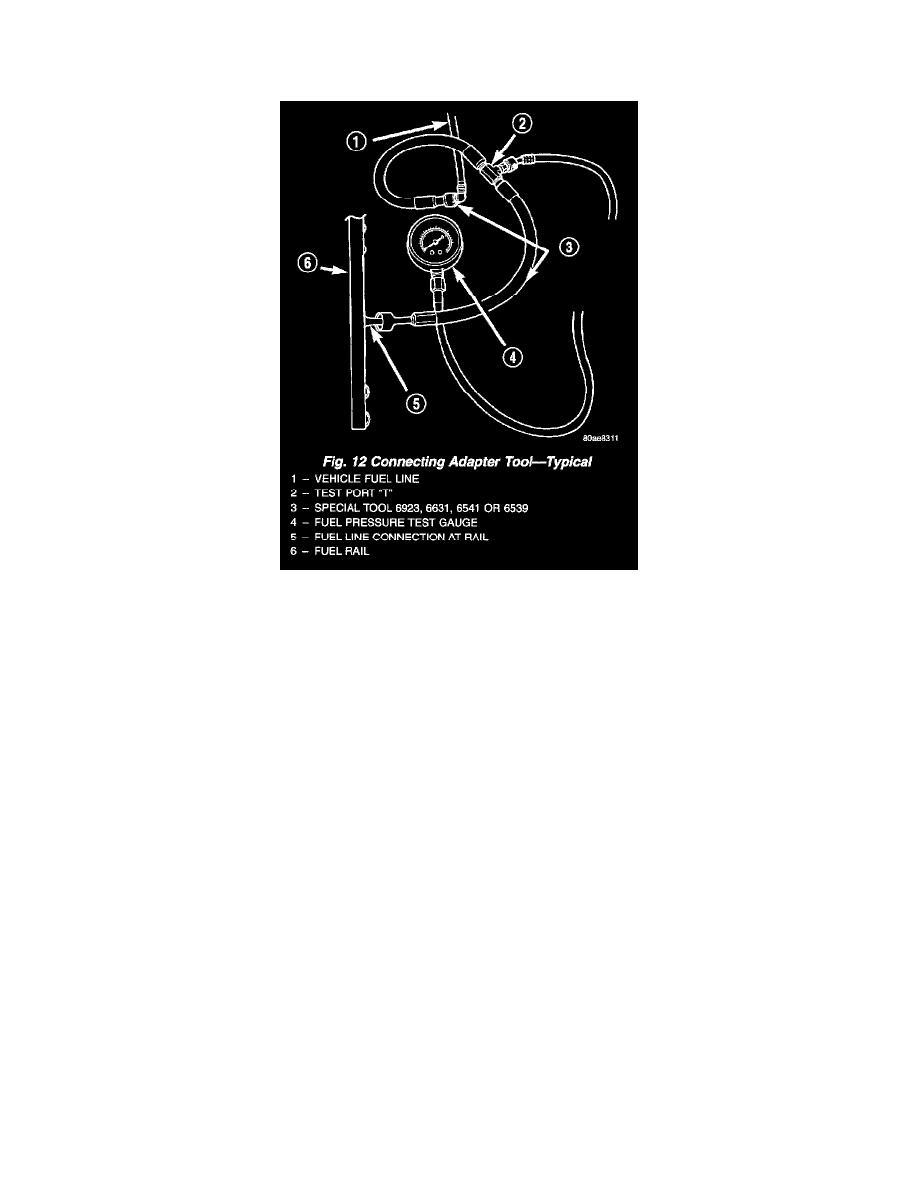Grand Cherokee 2WD V8-4.7L VIN N (2000)

5. Lower vehicle.
6. Disconnect the fuel inlet line at fuel rail. Refer to Quick-Connect Fittings for procedures. On some engines, air cleaner housing removal may be
necessary before fuel line disconnection.
Fig. 12 Connecting Adapter Tool - Typical
7. Obtain a second Fuel Line Pressure Test Adapter Hose Tool # 6539 for 5/16" fuel lines. Connect this tool between disconnected fuel line and fuel
rail (Fig. 12).
8. Connect the 0 - 414 kPa (0 - 60 psi) fuel pressure test gauge (from Gauge Set 5069) to the test port on the appropriate Adaptor Tool. NOTE: The
DRB III Scan Tool along with the PEP module, the 500 psi pressure transducer, and the transducer-to-test port adapter may also be used in place
of the fuel pressure gauge.
CAUTION: The fittings on both tools must be in good condition and free from any small leaks before performing the proceeding test.
9. Start engine and bring to normal operating temperature.
10. Observe fuel pressure test gauge (or DRB screen). Normal operating pressure should be 339 kPa ± 34 kPa (49.2 psi ± 5 psi).
11. Shut engine OFF.
12. Pressure should not fall below 0 psi for five minutes.
13. If pressure falls below 30 psi, it must be determined if a fuel injector, the supply check valve within the fuel pump module, the fuel filter/pressure
regulator, or a fuel tube/line is leaking.
14. Again, start engine and bring to normal operating temperature.
15. Shut engine OFF.
16. Testing for fuel injector or fuel rail leakage: Clamp off the rubber hose portion of the 6539 Adaptor Tool between the fuel rail and the test port on
Adapter Tool (be sure clamping pressure is sufficient). If pressure now holds at or above 30 psi, a fuel injector or the fuel rail is leaking.
17. Again, start engine and bring to normal operating temperature.
18. Shut engine OFF.
19. Raise vehicle.
20. Testing for fuel filter/pressure regulator leakage: While continuing to securely clamp between the fuel rail and the test port "T" on Adaptor Tool
6539, securely clamp off any rubber hose portion of the Adaptor Tool 6539 that was installed between the fuel pressure line and the filter/regulator
fitting (by restricting the pump module supply line's backflow, you isolate any leakdown originating from the filter/regulator via the tank return
line.) If the pressure falls below 30 psi within 5 minutes, the filter/regulator is leaking. If it now holds at or above 30 psi, the electric fuel pump
check valve is leaking or a fuel tube/line is leaking. A fuel odor presence would indicate the latter.
The electric fuel pump is not serviced separately. If replacement is necessary, replace the fuel pump module assembly. The filter/regulator may be
replaced separately. Refer to Fuel Filter/Fuel Pressure Regulator Removal/Installation for additional information.
